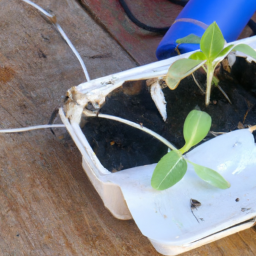Electroculture Gardening How To
Table of Contents []
- Electroculture Gardening How To
- Features of Electroculture Gardening
- Benefits of Electroculture Gardening
- Pros and Cons of Electroculture Gardening
- Case Studies of Electroculture Gardening
- Frequently Asked Questions about Electroculture Gardening
- Common Mistakes People Make with Electroculture Gardening
- Best Practices for Electroculture Gardening
- Conclusion
- Final Notes
Electroculture Gardening How To
Understanding Electroculture Gardening: An Introduction to Pros, Cons, Benefits, and Best Practices
Electroculture Gardening (ELG) is an innovative gardening method that applies electricity to improve the growth of plants. Through applying carefully controlled and targeted electric fields, ELG can increase crop yields, mitigate soil degradation, and respect the environment. In this article, we will explore the features, benefits, pros & cons, case studies, FAQs, mistakes to avoid, and best practices of Electroculture Gardening.
Features of Electroculture Gardening
Electroculture Gardening has a lot of features that make it unique from other gardening methods. Firstly, ELG reduces the amount of water used for irrigation due to increases in the soil's absorption capacity. It also enriches the soil's organic matter content, which allows it to retain more moisture. Nitrogen is circulated more efficiently through the soil, reducing the need for expensive nitrogen-based fertilizers. Lastly, ELG can protect against plant-damaging elements such as bacteria and viruses.
Benefits of Electroculture Gardening
The benefits of Electroculture Gardening are numerous. Firstly, it increases crop yields by 30-50%, leading to increased profitability. It also decreases the need for costly herbicides and insecticides, which can be harmful to the environment. Lastly, ELG can help mitigate soil degradation and protect crops from diseases.
Pros and Cons of Electroculture Gardening
ELG has both pros and cons. On the plus side, it can increase crop yields and improve the soil's absorption capacity. It also reduces the need for expensive nitrogen-based fertilizers and herbicides. On the downside, ELG can be expensive to set up and maintain, and it requires a significant amount of energy to power the electric fields.
Case Studies of Electroculture Gardening
To illustrate the effectiveness of ELG, several case studies can be looked into. In Belgium, ELG was used in the commercial cultivation of artichokes. After almost a decade of installation, the system had a positive impact on the artichoke yield and the quality of the artichokes. In Costa Rica, ELG was used to control the spread of borne pathogens in a high-value banana crop, yielding positive results.
Frequently Asked Questions about Electroculture Gardening
Q: What does Electroculture Gardening involve?
A: ELG is a method of gardening that applies electricity to improve the growth of plants. It reduces the amount of water used for irrigation, enriches the soil's organic matter content, and can protect against plant-damaging elements like bacteria and viruses.
Q: What are the benefits of Electroculture Gardening?
A: The benefits of ELG include increased crop yields by 30-50%, decreased need for costly herbicides and insecticides, and protection against soil degradation.
Q: What are the drawbacks of Electroculture Gardening?
A: The drawbacks of ELG include it being expensive to set up and maintain, and the need for a significant amount of energy to power the electric fields.
Common Mistakes People Make with Electroculture Gardening
One of the most common mistakes made when using Electroculture Gardening is improper installation. ELG needs to be installed carefully to ensure it works properly. Without proper installation, it may not yield the desired results. Another mistake is to use too much power. Too much electricity can damage the plants, so it's important to use the right amount of power.
Best Practices for Electroculture Gardening
For those looking to get the most out of their ELG system, there are some best practices to follow. Firstly, it's important to ensure the system is installed correctly. It's also important to keep track of the electricity used and to use the right amount of power for the plants. Additionally, it's important to monitor the system regularly and make changes when necessary.
Conclusion
Electroculture Gardening is a revolutionary gardening method that can increase crop yields, mitigate soil degradation, and respect the environment. It has a lot of features, benefits, pros & cons, and case studies to explore. Additionally, there are common mistakes to avoid and best practices to follow for those looking to get the most out of their ELG system. With the right knowledge and understanding, Electroculture Gardening can be a beneficial and cost-effective way to produce quality crops.
Final Notes
Understanding Electroculture Gardening is an important step for any gardener. With the right knowledge and understanding, ELG can be a powerful tool in producing quality crops. To get the most out of your ELG system, it's important to follow best practices and be aware of common mistakes to avoid. With these tips in mind, you can make the most out of your Electroculture Gardening system.

Previous Page
Next Page